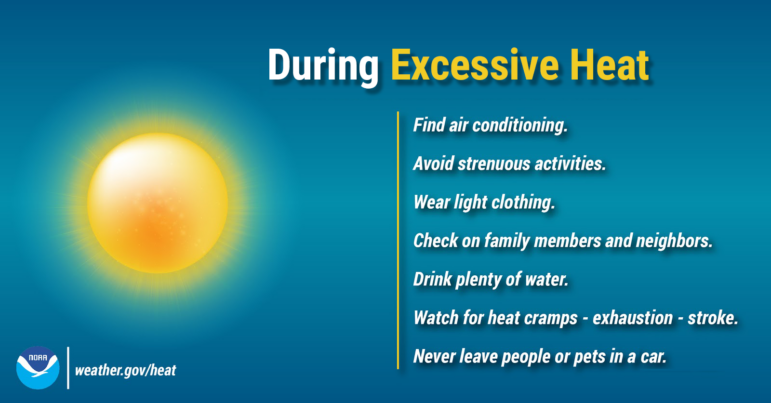This is a developing situation and information may change. We’ll update this article as more information becomes available. The most recent information will be updated at the top of the article, with the earlier reports below.
MENDOCINO Co., 6/28/23 — After unseasonably cool temperatures, Mendocino County will experience its first heat wave of the year this holiday weekend. The National Weather Service is forecasting temperatures to rise significantly across Northern California, reaching over 100 degrees in parts of eastern interior Mendocino County and portions of Lake County. Here’s an overview of what’s to come with additional resources at the end of the article.
The extreme heat increases the likelihood of heat related illnesses, especially for those working or participating in outdoor activities, as well as the young, elderly, pets, and plants. We have a list of tips and resources at the bottom of this article on how to be safe during heat waves.

The National Weather Service Eureka (NWS Eureka) has issued an excessive heat watch for northeastern Mendocino County, including Covelo, and the entirety of Lake County. The watch is in effect from 1 p.m. Fri. June 30 through 9 p.m. Sun. July 2. An excessive heat watch is issued when conditions are favorable for an excessive heat event in the next 24 to 72 hours.
According to NWS Eureka, the areas under the watch may experience “dangerously hot conditions with temperatures up to 106 degrees possible.” Covelo will experience triple digit temperatures ranging from 101 degrees starting on Thursday to 104 degrees on Sunday with overnight temperatures averaging in the low 60s. If you plan to head over to Blue Lakes, Clear Lake or Lake Mendocino, expect high temperatures in the low 100s.
NWS Eureka has also issued a heat advisory for southeastern interior Mendocino County, including Ukiah and Hopland, from 1 p.m. to 8 p.m. Sat. July 1. These communities will experience temperatures in the 100s, with Saturday forecast as the hottest day atf 106 degrees. On that note, it’s likely many interior residents will flock to the Mendocino Coast to enjoy nature’s air conditioning. Fort Bragg can expect sunny and cool weather in the low 60s.
Mendocino County Public Health has not opened cooling stations as of publication. Additionally, PG&E is not anticipating any public safety power shut offs. We will update this article if that changes.
Due to the diverse weather conditions of North Coast microclimates, hyperlocal weather may vary. You can check the weather forecast for your neighborhood or travel destination here.
Tips from the National Weather Service about heat waves:
Outdoor Activities
- Slow down. Reduce, eliminate or reschedule strenuous activities until the coolest time of the day. Those particularly vulnerable to heat such as children, infants, older adults (especially those who have preexisting diseases, take certain medications, living alone or with limited mobility), those with chronic medical conditions, and pregnant women should stay in the coolest available place, not necessarily indoors.
- Dress for summer. Wear lightweight, loose fitting, light-colored clothing to reflect heat and sunlight.
- Minimize direct exposure to the sun. Sunburn reduces your body’s ability to dissipate heat.
Eating and Drinking
- Eat light, cool, easy-to-digest foods such as fruit or salads. If you pack food, put it in a cooler or carry an ice pack. Don’t leave it sitting in the sun. Meats and dairy products can spoil quickly in hot weather.
- Drink plenty of water (not very cold), non-alcoholic and decaffeinated fluids, even if you don’t feel thirsty. If you are on a fluid-restricted diet or have a problem with fluid retention, consult a physician before increasing consumption of fluids.
- Do not take salt tablets unless specified by a physician.
Cooling Down
- Use air conditioners or spend time in air-conditioned locations such as malls and libraries.
- Use portable electric fans to exhaust hot air from rooms or draw in cooler air.
- Do not direct the flow of portable electric fans toward yourself when room temperature is hotter than 90°F. The dry blowing air will dehydrate you faster, endangering your health.
- Take a cool bath or shower.
Check on Others
- Check on older, sick, or frail people who may need help responding to the heat. Each year, dozens of children and untold numbers of pets left in parked vehicles die from hyperthermia. Keep your children, disabled adults, and pets safe during tumultuous heat waves.
- Don’t leave valuable electronic equipment, such as cell phones and GPS units, sitting in hot cars.
- Make sure rooms are well vented if you are using volatile chemicals.
Heat Safety in Vehicles
- Even on mild days in the 70s, studies have shown that the temperature inside a parked vehicle can rapidly rise to a dangerous level for children, pets and even adults. Leaving the windows slightly open does not significantly decrease the heating rate. A dark dashboard or car seat can quickly reach temperatures in the range of 180°F to over 200°F. These objects heat the adjacent air by conduction and convection and also give off long wave radiation, which then heats the air trapped inside a vehicle. Touch a child’s safety seat and safety belt before using it to ensure it’s not too hot before securing a child
- Never leave a child unattended in a vehicle, even with the windows down, even for just a minute
- Teach children not to play in, on, or around cars. They could accidentally trap themselves in a hot vehicle.
- Always lock car doors and trunks–even at home–and keep keys out of children’s reach.
- Always make sure children have left the car when you reach your destination. Don’t leave sleeping infants in the car.
- Click here to learn more and follow these tips to ensure childrens’ safety.
Pet Safety During Hot Weather
Here are tips from the ASPCA on how to keep your pets safe during hot weather
- Pets can get dehydrated quickly, so give them plenty of fresh, clean water when it’s hot or humid outdoors. Make sure your pets have a shady place to get out of the sun, be careful not to over-exercise them, and keep them indoors when it’s extremely hot.
- Know the symptoms of overheating in pets, which include excessive panting or difficulty breathing, increased heart and respiratory rate, drooling, mild weakness, stupor or even collapse. Symptoms can also include seizures, bloody diarrhea and vomit along with an elevated body temperature of over 104 degrees.
- Animals with flat faces, like Pugs and Persian cats, are more susceptible to heat stroke since they cannot pant as effectively. These pets, along with the elderly, the overweight, and those with heart or lung diseases, should be kept cool in air-conditioned rooms as much as possible.
- Never leave your animals alone in a parked vehicle. Not only can it lead to fatal heat stroke, it is illegal in several states!
- Do not leave pets unsupervised around a pool—not all dogs are good swimmers. Introduce your pets to water gradually and make sure they wear flotation devices when on boats. Rinse your dog off after swimming to remove chlorine or salt from his fur, and try to keep your dog from drinking pool water, which contains chlorine and other chemicals.
- Open unscreened windows pose a real danger to pets, who often fall out of them. Keep all unscreened windows or doors in your home closed, and make sure adjustable screens are tightly secured.
- Feel free to trim longer hair on your dog, but never shave your dog: The layers of dogs’ coats protect them from overheating and sunburn. Brushing cats more often than usual can prevent problems caused by excessive heat. And be sure that any sunscreen or insect repellent product you use on your pets is labeled specifically for use on animals.
- When the temperature is very high, don’t let your dog linger on hot asphalt. Being so close to the ground, your pooch’s body can heat up quickly, and sensitive paw pads can burn. Keep walks during these times to a minimum.
Sarah Stierch covers wildfires, breaking news, and more for The Mendocino Voice. You can follow Stierch on Twitter and learn more about her work and donate to her directly at here. Contact Stierch at [email protected]. The Voice maintains editorial control and independence.





